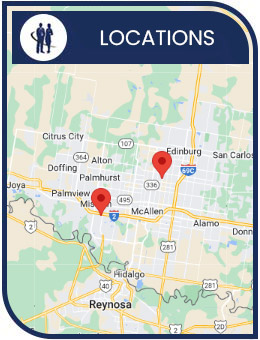Osteoporosis Doctor in Edinburg and Mission, TX
Osteoporosis is characterized by fragile, weakened bones that make fractures more likely. Back pain, height loss, and a tilted posture are some of the signs of osteoporosis. Medications that decrease bone loss and promote bone formation, as well as dietary and lifestyle changes may be used to treat osteoporosis. Improvements include sufficient calcium and vitamin D intake, weight-bearing activity, etc. It’s vital to talk to a healthcare provider if you have any osteoporosis symptoms or are worried about your risk of getting the disease. Visit us today at Catalyst Medical Group, where Dr. Padmini Bhadriraju, MD, and her team will provide you with the right care. For more information, contact us or schedule an appointment online. We have convenient locations to serve you in Edinburg TX, and Mission TX.


Table of Contents:
What are the first signs of osteoporosis?
What is the main cause of osteoporosis?
What is the best and safest treatment for osteoporosis?
What happens if osteoporosis is left untreated?
How can I reverse osteoporosis without medication?
Osteoporosis is a disease that affects the bones resulting in an increased risk of fractures. Unfortunately, osteoporosis often goes undiagnosed until a fracture occurs. Some initial signs of osteoporosis to look out for include:
– Back pain
– Loss of height
– Bad posture
– Weak and brittle fingernails
– Reduced gums
– Bone loss in the jaw
– Decreased grip strength
– Fractures
The listed symptoms can also be a sign of other illnesses, so an osteoporosis doctor should be consulted for a precise diagnosis. Early diagnosis and treatment of osteoporosis can also lessen the risk of fractures and help stop further bone loss.
The causes of osteoporosis include:
– Aging – As we grow older our bodies naturally lose bone mass and absorb less calcium and other minerals necessary for bone health.
– Hormonal changes – After menopause, estrogen levels in women quickly drop which can cause bone loss. Due to a drop in testosterone levels, men can also experience bone loss as they age.
– Genetics – Having a family history of osteoporosis can put you at a higher risk of developing the condition.
– Nutritional deficiencies – Maintaining bone health requires a diet that is adequate in calcium, vitamin D, and other nutrients.
– Physical inactivity – Bone loss and bone thinning can result from a lack of exercise.
– Medication – Some medications, including corticosteroids and some anticonvulsants can make you more likely to develop osteoporosis.
– Other medical conditions – Rheumatoid arthritis, celiac disease, and hyperthyroidism are a few conditions that can lead to osteoporosis if not treated effectively.
The best and safest osteoporosis treatment depends on the patient’s medical history, general health, and how severe their condition is. Some of the common osteoporosis treatments include:
– Lifestyle changes – Bone loss can be slowed down by leading an active, healthy lifestyle that includes regular exercise, a diet rich in calcium and vitamin D, and abstaining from smoking and excessive alcohol consumption.
– Medications – Several medications, including bisphosphonates, teriparatide, denosumab, and selective estrogen receptor modulators are used to treat osteoporosis. These drugs are effective in slowing bone loss and boosting bone density.
– Hormone replacement therapy (HRT) – HRT may be recommended for those who have experienced andropause or menopause. Estrogen and testosterone levels drop after this period in life, so HRT can be used to restore normal hormone levels.
– Fall prevention – To prevent fractures it’s important to lower the risk of falls. This involves making adjustments to the home environment such as removing trip hazards, installing assistive technology, and participating in balance and strength training programs.
If osteoporosis is not treated, the following complications can occur:
– Fractures – Osteoporosis causes bones to become weak and brittle, increasing the risk of fractures. The hip, spine, and wrist are the three most common places for fractures to occur.
– Chronic pain – Osteoporosis often causes chronic pain that interferes with daily life.
– Loss of mobility – Osteoporosis commonly results in mobility loss which raises the danger of falls and fractures.
– Poor posture – Osteoporosis can lead to compression fractures of the spine which result in a loss of height and a hunched posture.
The following methods can be used to treat osteoporosis without medication:
Exercise – Performing exercises regularly will help increase bone density and lower the risk of fractures. Recommended exercises include stair climbing, walking, hiking, and dancing.
Diet – Reversing osteoporosis requires a diet high in calcium, vitamin D, and other nutrients that support bone health. Dairy products, leafy greens, and supplements are a must!
Give up smoking – Quitting smoking leads to improved bone health as smoking has been linked to a decrease in bone density.
Fall prevention – Reducing tripping hazards, using assistive devices, and attending physical therapy are methods of preventing falls and fractures.
Reducing stress – Because prolonged stress can lead to bone loss using relaxation techniques such as yoga or meditation is beneficial.
Osteoporosis is a bone disease that appears when bone mass and mineral density decline or when the composition and strength of bones alter. As a result, there may be a decline in bone density and an elevated risk of fractures (broken bones). It is important to get it treated at an early stage. For more information, contact us today or book an appointment online. We have convenient locations to serve you in Edinburg TX, and Mission TX. We serve patients from Edinburg TX, McAllen TX, San Juan TX, Alamo TX, Pharr TX, Palmhurst TX, Mission TX, Alton TX and Palmview TX.




